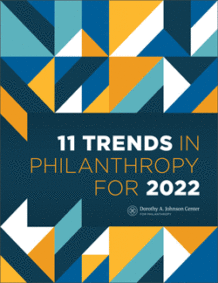Donors of Color are Mobilizing for Their Communities – Often at the Forefront of Emerging Trends


 This article was first published in our 11 Trends in Philanthropy for 2022 report. Explore all 11 trends in the full report.
This article was first published in our 11 Trends in Philanthropy for 2022 report. Explore all 11 trends in the full report.
Want the latest trends, research, and more delivered right to your inbox? Subscribe to the Johnson Center email newsletter.
Research from the Mays Institute on Diverse Philanthropy (2021) “indicates that about two-thirds of Black and Hispanic households and nearly one-half of Asian households gave to charity in a given year” (p. 12).
Giving by donors of color is a growing area of interest and attention for the philanthropic sector, as non-Hispanic Whites “are no longer projected to make up the majority of the U.S. population” beginning in 2045 (Vespa et al., 2020, p. 5).
What’s more, donors of color are themselves leading — or are playing an increasingly visible role in leading — many of the shifts we’re seeing in the field.
Giving among communities of color is nothing new (Akanjo, 2021). According to philanthropy historian Tyrone McKinley Freeman (2019), philanthropy in Black American communities came early, with leaders such James Forten, Thomy LaFon, and Clara Brown helping enslaved and formerly enslaved people to flee the south in the late 1700s and 1800s by financing abolitionist newspapers and the Underground Railroad and providing support in the aftermath of the Civil War.
Mutual aid societies developed in the late 1700s, working to abolish slavery. The end of the U.S.-Mexican War in 1848 gave rise to many more in an effort to help Mexican immigrants settle across the southwest (Duran, 2001). Many of these mutual aid societies existed well into the 1960s.
In the 21st century, we’ve seen notable gifts from donors of color, like Cuban-born Alberto Vilar’s $50 million gift to the Kennedy Center in 2001, and Robert F. Smith’s gift to graduates of Morehouse College. Smith announced during a commencement speech “that he would pay off the student loan debt of the entire 2019 graduating class of about 400 young men from the historically black school” (Freeman, 2019, para. 1).
Everyday examples of giving by donors of color are often crowded out by reports of the continued wealth gap in this country. That gap can foster a public misconception that communities of color are primarily on the receiving end of philanthropy rather than the side of generosity.
However, the data also point to a very different story. While the “black-white income gap has held steady since 1970” (Schaeffer, para. 7), “black families have contributed the largest proportion of their wealth … to charity since 2010” (Ashley & James, 2018, para. 2) as compared to whites and other ethnic groups.
“Black and Asian donors are more likely to donate goods, volunteer their time, and even donate blood. Black donors are the most likely to give to people they know, both with direct monetary gifts and in non-financial ways.”
Furthermore, because giving by donors of color often looks different than among white communities and varies tremendously across the board, this generosity has often been missed by traditional forms of collecting information, such as surveys and tax filings (Vaid & Maxton, 2017). Black and Asian donors are more likely to donate goods, volunteer their time, and even donate blood. Black donors are the most likely to give to people they know, both with direct monetary gifts and in non-financial ways (Mays Institute, 2021).
Take a look at the sector: as we examine many of the major shifts that are redefining avenues of giving and engaging, we see donors of color taking the lead and embracing innovation.
Household Giving
Despite an overall decline in household giving over the last 20 years, donors of color may be turning that tide. The pandemic and racial reckoning of 2020 saw an increase in giving by donors of color that outpaced white donors. According to the Blackbaud Institute’s 2021 Tipping Point report, “Nearly half (46%) of Black donors say they gave more, with Hispanic (44%) and Asian (38%) donors close behind” (para. 17). Blackbaud’s data also revealed that donors of color were more likely to give to new organizations in 2020, with Hispanic donors the most likely to do so.
Building Infrastructure for Givers of Color
Fueled by continued disparities, “racialized groups have bonded with each other over their shared experiences, which has led to many racialized groups sharing a sense of economic reciprocity with each other” (Mays Institute, 2021, p. 11).
This sense of shared experiences and bonding is giving rise to a number of philanthropic giving networks and initiatives, like the Donors of Color Network, Borealis Philanthropy, the Community Investment Network, and Give 8/28, which raised over $177,000 in just one day in 2021.
New avenues for giving and convening are also springing up among donors of color, as represented by the May 2021 launch of the Asian American Foundation. Founded in response to the increasing number of hate crimes against Asian Americans, the founding “record-breaking donation of $125 million … is the largest commitment ever made by Asian Americans to their own community” (Elkind, 2021, paras. 1, 2).
Giving Circles
As the movement for giving circles continues to gain momentum, donors of color are often leading the way, marshaling a form of giving that more closely aligns with traditions of collective philanthropy (Philanthropy Together, n.d.). A report from the Collective Giving Research Group (2017) indicates that newer members of giving circles tend to be more diverse, with Latino/a participation especially on the rise.
High Net Worth Donors
The growing number of high net worth individuals is often hidden in plain sight due to systemic racism and the historic lack of research focused on donors of color. A 2017 report projected, “1.3 million African American, Asian, and Hispanic individuals across the U.S. with a net worth of over $1 million” (Vaid & Maxton, p. 3).
Cryptocurrency
At the 2021 Black Blockchain Summit, some 1,500 mostly Black people, gathered at Howard University “to talk about crypto … as a way to make money while disrupting centuries-long patterns of oppression” (Ross, para. 2). A 2021 report from NORC at the University of Chicago demonstrated that “Two-fifths of crypto traders are not white” (para. 2). That 44% of crypto traders might just be the next generation of mega-donors.
As communities of color continue to navigate economic disparity, continued racism, and unprecedented health crises resulting from the pandemic, they are mobilizing in innovative ways for a collective philanthropic impact.
Akanjo, O. (2021, July 22). Black women in philanthropy: The art of everday giving as activism. NPQ. https://nonprofitquarterly.org/black-women-in-philanthropy-the-art-of-everyday-giving-as-activism/
Ashley, S., & James, J. (2018, February 28). Despite the racial wealth gap, black philanthropy is strong. Urban Institute. https://www.urban.org/urban-wire/despite-racial-wealth-gap-black-philanthropy-strong
Blackbaud Institute. (2021). Tipping point. New donors and more diversity. https://institute.blackbaud.com/tippingpoint/
Borealis Philanthropy. (n.d.). https://borealisphilanthropy.org
Collective Giving Research Group. (2018, November). Giving circle membership: How collective giving impacts donors. https://scholarworks.iupui.edu/bitstream/handle/1805/17743/giving-circle-membership18.pdf
Community Investment Network. (n.d.). https://www.thecommunityinvestment.org
Donors of Color Network. (n.d.). https://www.donorsofcolor.org
Duran, L. (2001, September, October). Caring for one another. Grassroots Fundraising Journal. https://coco-net.org/wp-content/uploads/2012/08/20_5_PhilCommOfColor.pdf
Elkind, E. (2021, May 3). New foundation gives record $125 million to AAPI causes as anti-Asian hate crimes surge in 2021. CBS News. https://www.cbsnews.com/news/hate-crime-surge-asian-american-foundation-launch/
Freeman, T. M. (2019, August 22). 400 years of black giving: From the days of slavery to the 2019 Morehouse graduation. The Conversation. https://theconversation.com/400-years-of-black-giving-from-the-days-of-slavery-to-the-2019-morehouse-graduation-121402
Give 8/28. (2021). https://www.give828.org/giving-events/ybgb21
Mays Institute on Diverse Philanthropy. (2021, August). Everyday donors of color. Indiana University Lilly Family School of Philanthropy. https://scholarworks.iupui.edu/bitstream/handle/1805/26496/donors-color-report.pdf
NORC. (2021, July 22). More than one in ten Americans surveyed invest in cryptocurrencies. NORC at the University of Chicago. https://www.norc.org/NewsEventsPublications/PressReleases/Pages/more-than-one-in-ten-americans-surveyed-invest-in-cryptocurrencies.aspx
Philanthropy Together. (n.d.). What is a giving circle? https://whatisagivingcircle.com
Ross, J. (2021, October 15). Inside the world of Black bitcoin, where crypto is about making more than just money. Time. https://time.com/6106706/bitcoin-black-investors/
Schaeffer, K. (2020, February 7). 6 facts about economic inequality in the U.S. Pew Research Center. https://www.pewresearch.org/fact-tank/2020/02/07/6-facts-about-economic-inequality-in-the-u-s/
Vaid, U., & Maxton, A. (2017). The apparitional donor: Understanding and engaging high net worth donors of color. The Advancement Project and The Vaid Group LLC. https://www.donorsofcolor.org/wp-content/uploads/2019/01/FinalAppDonreport4.17.pdf
Vespa, J., Medina, L., & Armstrong, D. M. (2020, February). Demographic turning points for the United States: Population projections for 2020 to 2060, Current Population Reports. U.S. Census Bureau. https://www.census.gov/content/dam/Census/library/publications/2020/demo/p25-1144.pdf
W.K. Kellogg Foundation. (2012, January). Cultures of giving energizing and expanding philanthropy by and for communities of color. https://www.giarts.org/sites/default/files/Cultures-of-Giving_Energizing-and-Expanding-Philanthropy-by-and-for-Communities-of-Color.pdf